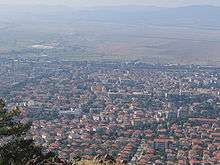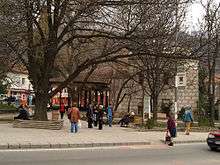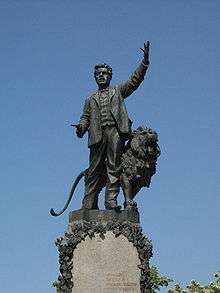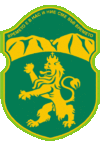Karlovo
| Karlovo Карлово | ||
|---|---|---|
|
View from Karlovo | ||
| ||
 Karlovo Location of Karlovo | ||
| Coordinates: 42°38′37″N 24°48′26″E / 42.64361°N 24.80722°ECoordinates: 42°38′37″N 24°48′26″E / 42.64361°N 24.80722°E | ||
| Country | Bulgaria | |
| Province (Oblast) | Plovdiv | |
| Area | ||
| • Total | 102.173 km2 (39.449 sq mi) | |
| Elevation | 452 m (1,483 ft) | |
| Population (2012) | ||
| • Total | 30,340 | |
| • Density | 300/km2 (770/sq mi) | |
| Time zone | EET (UTC+2) | |
| • Summer (DST) | EEST (UTC+3) | |
| Postal Code | 4300 | |
| Area code(s) | 335 | |
| Website | Official website | |

Kàrlovo (Bulgarian: Карлово) is a picturesque and a historically important town in central Bulgaria located in a fertile valley along the river Stryama at the southern foot of the Balkan Mountains. It is administratively part of Plovdiv Province and has a population of about 30,340 (as of 2011), the mayor being D-r Emil Kabaivanov.
Karlovo is famous for the worldwide-known rose oil, which is grown there and used in producing perfume. In addition to this, Karlovo is the birthplace of Vasil Levski, the most distinguished Bulgarian to start preparing the national liberation from the Ottoman rule in the late 19th century. There is a museum and large monument dedicated to him. Karlovo is also a popular location for tourism in the region.
During the 2000s, Bulgarian archaeologists made discoveries in Central Bulgaria which were summarized as "The Valley of the Thracian Kings". On 19 August 2005, some archaeologists announced they had found the first Thracian capital, which was situated near Karlovo in Bulgaria. A lot of polished ceramic artifacts (pieces of roof-tiles and Greek-like vases) were discovered revealing the fortune of the city. The Bulgarian Ministry of Culture declared its support to the excavations.
History

Karlovo is a successor of the medieval fortress of Kopsis (Копсис in Bulgarian, Kωψίς or Κόψη in Byzantine Greek), a feudal possession of Smilets of Bulgaria in the 13th-14th century and the likely capital of his brother despotēs Voysil's short-lived realm. The modern town originated in 1483 at the place of the village of Sushitsa (still today Sushitsa is one of Karlovo's districts), but grew in importance in the 19th century as a centre of Bulgarian culture and revolutionary activity. In 1876 Lady Strangford arrived from Britain with relief for the people of Bulgaria following the massacres that followed the April Uprising. She built a hospital at Batak and eventually other hospitals were built at Radilovo, Panagiurishte, Perushtitsa, Petrich and here at Karlovo.[1]
From 1953 until 1962, the city was called Levskigrad.
Geography
Karlovo lies at 42°38′N 24°48′E / 42.633°N 24.800°E, 386 metres (1,266 feet) above sea level. It is located in the Valley of Roses, famous for the big-scale production of roses. When arriving in the city, one is immediately struck by the austere beauty of the Stara Planina mountain, which virtually hangs above the city. The highest peak of this famous mountain range — Botev, 2376m — is actually pretty close to Karlovo. The city is located 140 kilometres (87 miles) east from the Bulgarian capital — Sofia, and 60 km (37 mi) north from Plovdiv, the second biggest Bulgarian city and the capital of the Plovdiv Province.
Climate
The climate of the region is temperate continental, with mild and warm summers, refreshed by the wind coming down the Balkan Mountain, and snowy winters. The average January temperature is 0.1 °C (32.2 °F) (with an absolute minimum of −25.8 °C (−14.4 °F)). The average July temperature is 22.9 °C (73.2 °F) (with an absolute maximum of 39.6 °C (103.3 °F)).
Average total annual rainfall is 694 mm (27 in), being highest in the summer 221 mm (9 in), and lowest in the winter 169 mm (7 in).
Infrastructure and transport
Karlovo is located on the main road E 78, one of the two roads which connect the capital Sofia to the southern part of the Black Sea. The city is an important point on the railway between Sofia and the commercially important Black Sea port of Burgas. There are frequent trains to the second biggest railway station in the country — Plovdiv. The total road length on the territory of Karlovo municipality is 301.4 km (187.3 mi). Karlovo is only 50 km (31 mi) away from the most important road in Bulgaria - Trakiya motorway, which is actually the main road between Sofia and Istanbul. The international road to Bucharest is also just 50 km (31 mi) away.
Municipality

Karlovo is the seat of Karlovo municipality (part of Plovdiv Province). The population of the Karlovo municipality is approximately 73,000 people. It includes the following 27 towns and villages (towns in bold):
|
Notable natives
- Evlogi Georgiev (1819–1897), merchant, banker and entrepreneur
- Ivan Bogorov (c. 1820–1892), encyclopedist
- Vasil Levski (1837–1873), revolutionary and national hero of Bulgaria
- Hristo Prodanov (1943–1984), first Bulgarian to climb Mount Everest
- Nelly Petkova (b. 1983), pop and folklor singer
- Anka Lambreva (1895–1976), first Bulgarian woman to circumnavigate the world
Notable events
- The Day of the Rose in the first days of June
- Anniversary of Vasil Levski's death
Attractions
Landmarks
- Suchurum Waterfall. The 15-metre-high (49-foot) Suchurum (flying water) waterfall is also known as the Karlovo waterfall.
It is located right below the Karlovo water-power station, on the left tributary of Stryama River - Stara Reka, taking its sources from the two tributaries – the Malkata Reka springing South of the peaks of Ambaritsa and Malak Kupen and Golyamata River – springing South below the peak of Zhultets. With its number of rapids, small pools and chutes above Karlovo, Stara Reka descends from 15 metres (49 feet) in a picturesque waterfall.
- National park "Central Balkan". The National Park “Central Balkan” is situated in the heart of Bulgaria, in the central and highest parts of the Balkan Mountain. The highest peak in the Park is Botev peak (2376). The lowest point is situated near Karlovo, on altitude of 500 metres (1,600 feet). The park occupies a total area of 72 021 ha and includes parts of the territories of 5 administrative areas – Lovech, Gabrovo, Stara Zagora, Plovdiv and Sofia. The Park includes 9 natural reserves – “Boatin”, “Tsarichina”, “Kozya Stena”, “Steneto”, “Severen Dzhendem”, “Peeshti Skali”, “Sokolna”, “Dzhendema” and “Stara Reka”. The reserves occupy an area of 20,019.6 ha. Eight of them (excluding “Kozya Stena”) and “Central Balkan” Park are included in the UN list of national parks and other protected territories. Boatin, Tsarichina, Dzhendema and Steneto are a part of the network of biosphere reserves.In 2003 the National Park “Central Balkan” became a member of PAN Parks, which is an international appraisal of its well preserved and managed wild nature. In 2004 a holder of the PAN Parks certificate is also the park region.
Museums
- "Vasil Levski" National Museum. National Museum “Vasil Levski” is dedicated to Vasil Levski and covers his house, exhibition hall, Memorial Chapel “Halloween Bolgarskii” and Chardaklievata house. For several decades it has collected and stored belongings, documents and photos relating to family life and work of Vasil Levski, its associates and from Karlovo and other parts of the country. It Keeps almost all scientific research and biographical literature devoted to Levski works of art. In 2000, the museum complex was built and designed by architect Mary Karazlateva Memorial Chapel “Halloween Bolgarskii” in honor of the Apostle. It keeps part of his hair. National Museum “Vasil Levski” is part of the 100 Tourist Sites of Bulgaria by the Bulgarian Tourist Union.Open year-round. Summer Hours: 8:30 - 13:00 and 14:00 to 17:30; Winter hours: 08:00 to 13:00 and 14:00 to 17:00.
- Municipal Historical Museum - Karlovo. The museum exposition is settled in the building of the ancient Bulgarian school, a significant architectural and historical monument of culture (1871). Two are the main expositions: "Ethnography" and "Bulgarian National Revival". Special attention is to be paid to the Ethnographic department, where art jewelers, tissues and tools of ancient crafts are collected and exposed.A huge number of documents and belongings of the economic, cultural and social life in the town of Karlovo are exposed in "The Bulgarian Revival" department. Part of the museum is also the ethnographic collection in the Mazakova house built around 1848. It is located in the Old Town of Karlovo and is an architectural and historical cultural monument. A permanent ethnographic exhibition is arranged in it, presenting original fabrics, traditional costumes of Karlovo, domestic crafts and more.
The museum is open year-round working hours: 08:00 to 12:00 and 13:00 to 17:00 pm
- Architectural and Historical Reserve “The Old Town”. It has preserved the spirit of the Bulgarian National Revival despite the modern architectural style. This part of the town has preserved about 115 houses, monuments of culture. The old houses of Karlovo have high architectural value with their woodcarved ceilings, the yards with decorative doors and marvelous Murals on the stonewalls, the silent cobbled yards and shady vines, box shrub and flower gardens.
- The Bouhalov Han (Inn). The inn was once used to host the Bulgarian Revolutionary Central Committee founded by Vassil Levski; as well as the meetings of the Karlovo “Friends of Learning” group. The first “Abstention from Drinking” Association was also founded in the inn. Later on, until the end of the 1950s, the town’s Community Centre and the Library had been hosted in that building. According to the will of Kirko Bouhalov’s daughter, Penka Popova, the building was donated to the town in 1937. During the 1970s, the building was transformed into a students’ hostel but, due to its poor condition, the town authorities closed it. For 20 years the Bouhalov Han (Inn) had been staying lifeless and slowly turning to ruins, thus taking away part of the Revival Period history of that beautiful town. The building is now a Handicrafts’ Centre, since Karlovo has preserved alive even today the traditional handicrafts, such as: Goldsmith’s and Coppersmith’s trade, carpet industry, Pottery, woolen braiding manufacturing, Wood carving, cooperage, Engraving, icon-painting (Iconography), Kalofer lace and many others.
Other
- The Vasil Levski Monument. The impressive monument of Vasil Levski was built in 1903-1907 by Marin Vasilev is situated in the center of the Old townof Karlovo, near the “St. Nikola” church. The sculptor has depicted the Apostle of freedom Vasil Levski in full length, with a revolver in his hand. Next to him stands the roaring lion (i.e. the people). The low relief on both sides of the monument is covered with the names of the people from Karlovo who died for the Liberation of Bulgaria.
Honour
Karlovo Peak on Livingston Island in the South Shetland Islands, Antarctica is named after Karlovo.
Town twinning
 Bryansk, Bryansk Oblast, Russia
Bryansk, Bryansk Oblast, Russia Konin, Poland
Konin, Poland Baranovichi, Belarus
Baranovichi, Belarus
Gallery
 Historical Museum
Historical Museum Belfry of the St Nicholas Church
Belfry of the St Nicholas Church The grave of Levski's mother
The grave of Levski's mother Teodor and Anna Pulievi School of Economy
Teodor and Anna Pulievi School of Economy Lazarov School, 1892
Lazarov School, 1892 Monument to Vasil Levski, picture before 1949
Monument to Vasil Levski, picture before 1949 20 July Square
20 July Square
References
- ↑ Shurbanov, Alexander (1996). Victorian England ~ Literary Perspective in Bulgaria. Sofia.
- Константинов, Петър (1996). "Градът в долината на розите". Къща-музей Васил Левски в Карлово. София: Славина. pp. 29–37.
- Karlovo - Museum "Vasil Levski" (in Bulgarian)
- Karlovo information from Bulgarian Tourism
- Karlovo information from visitcentralbalkan.net
External links
| Wikimedia Commons has media related to Karlovo. |
- Official web site
- Info site about the region of Karlovo (in Bulgarian and English)
- All about Karlovo
- Startsi-Kukeri-Mummers of Karlovo Region, Bulgaria
- Actual information about Karlovo and the region
 |
Troyan | Troyan | Gabrovo |  |
| Sopot | |
Kazanlak | ||
| ||||
| | ||||
| Pazardzhik | Plovdiv | Stara Zagora |

